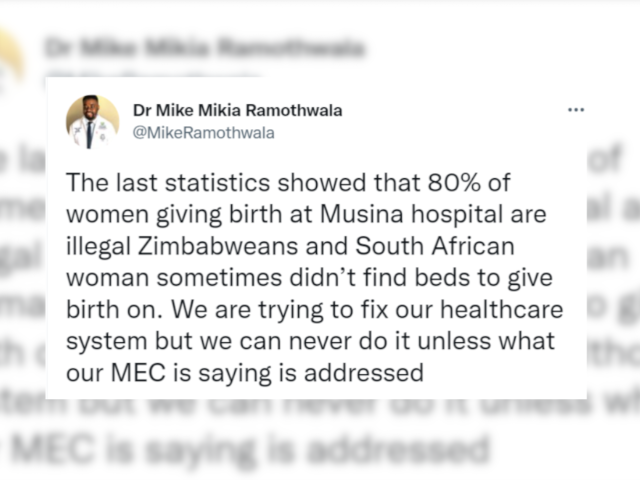This article is more than 6 years old
South Africa’s national airline is robbing South Africans of resources that could be put to better use, the country’s Democratic Alliance (DA) party claimed.
The official opposition recently put up a billboard to highlight the scale of government money spent on South African Airlines.
The DA’s billboard at Park Station in Johannesburg stated: “4 children die of hunger every day in SA”.
A couple of our readers asked us to verify this claim.
Africa Check asked the DA for the source of the claim. The manager of the party’s press office in parliament, Georgina Alexander-Maree, said it was from a parliamentary reply.
In March 2017, South Africa’s health minister Aaron Motsoaledi was asked how many admissions and deaths due to severe malnutrition were recorded in the country’s provincial hospitals in the 2013/2014, 2014/2015 and 2015/2016 financial years.
In his written response, Motsoaledi provided a provincial breakdown and total of the number of children under five admitted with severe malnutrition over the three year period.
Alexander-Maree told Africa Check that the use of the word children on the billboard refers to “those under 5 years of age”, while hunger “refers to severe malnutrition”.
Strictly speaking, hunger and malnutrition are not the same thing, nutrition experts warn.
“The term malnutrition includes both overnutrition (overweight/obesity), undernutrition and micronutrient malnutrition (hidden hunger),” said Sharmilah Booley, a lecturer in the division of human nutrition at the University of Cape Town’s health sciences faculty.
“Undernutrition includes underweight (which reflects a low weight for age), wasting (which reflects a low weight for height) and stunting (which reflects a low height for age).”
Severe acute malnutrition is the worst and most visible form of undernutrition, caused by not eating enough food, the United Nations’ children’s rights agency UNICEF explains.
According to the World Health Organisation, signs of severe acute malnutrition in children include a mid-upper arm circumference of less than 11.5 cm, or a weight-for-height ratio that is three or more points lower than the growth standard set by the WHO.
South Africa’s District Health Barometer is an annual report that provides statistics and analysis of important health indicators. It is published by the Health Systems Trust (HST), a health policy and development organisation in South Africa.
The barometer’s data on malnutrition is sourced from the District Health Information System (DHIS), a software programme used to report on outcomes from health facilities. It showed that, on average, 3.8 children died every day due to severe acute malnutrition in the last financial year for which data is available.
Source: District Health Barometer 2015/16
While the decline in the death rate to lower than 10% in the last financial year “is clearly a success story”, the barometer noted, it “remains unacceptably high for a middle-income country such as South Africa”.
The severe acute malnutrition death rate recorded is largely based on reports from government clinics and hospitals, Candy Day, one of the barometer’s editors, told Africa Check.
“Therefore it is reasonably comprehensive of facility-based deaths, but not complete and not including those occurring outside of facilities,” she said. (Note: The barometer’s totals differ marginally from the ones supplied by Motsoaledi. Day told Africa Check it could be due to occasional updates or corrections.)
“Many children in South Africa have limited or no access to health services,” Booley said. “Not all deaths occur in health facilities.”
In addition, there are problems with the correct identification and reporting of children being admitted due to malnutrition, as well as the associated deaths.
“It is probable that the rate of children with severe acute malnutrition in South Africa is understated,” one of the founders of the Health Systems Trust, David Harrison, told Africa Check. He said that at times, children are admitted with pneumonia or diarrhoea, when the underlying cause is really malnutrition.
The method by which to decide if the cause of death is due to, say pneumonia, or malnutrition, is not standardised, the barometer notes. Furthermore, some large hospitals have been reporting implausibly low numbers of admissions and deaths from severe acute malnutrition.
South Africa’s official political opposition party launched a campaign to highlight where they think money could be better used instead of bailing out the national airline.
On a billboard, the party claimed that “4 children die of hunger in South Africa every day”. The party was referring to children succumbing to severe acute malnutrition, of which 3.8 children died on average in the 2015/16 financial year.
“In order to be 100% strictly accurate, the billboard should have said that the 4 children die from severe acute malnutrition,” one of the founders of a health policy and development organisation in South Africa said.
“However, we understand that this wouldn’t have the same catchy impact on a billboard as hunger,” David Harrison added. “Hunger is not a bad proxy for the term ‘lack of food’, which in most cases leads to malnutrition.”
However, the problem could be worse than the billboard highlighted. Some children die outside health facilities or their deaths are misclassified. An editor of South Africa’s District Health Barometer told Africa Check that it is difficult to say to what extent child deaths due to malnutrition could be understated.
Given that the claim requires clarification, we rate it mostly correct.
Additional reading:
https://africacheck.org/reports/1-5-south-african-kids-skip-breakfast-ad-said/
https://africacheck.org/2017/10/30/analysis-billions-sa-airways-bailout-money-not-enough-buy-emirates/
The official opposition recently put up a billboard to highlight the scale of government money spent on South African Airlines.
The DA’s billboard at Park Station in Johannesburg stated: “4 children die of hunger every day in SA”.
We need work for our People. We need economic growth. Our people want to put food on the table. We need a New Beginning. #SAAcrisis pic.twitter.com/K5lluPgL2D
— Mmusi Maimane (@MmusiMaimane) October 23, 2017
A couple of our readers asked us to verify this claim.
Stat from a parliamentary reply
Africa Check asked the DA for the source of the claim. The manager of the party’s press office in parliament, Georgina Alexander-Maree, said it was from a parliamentary reply.
In March 2017, South Africa’s health minister Aaron Motsoaledi was asked how many admissions and deaths due to severe malnutrition were recorded in the country’s provincial hospitals in the 2013/2014, 2014/2015 and 2015/2016 financial years.
In his written response, Motsoaledi provided a provincial breakdown and total of the number of children under five admitted with severe malnutrition over the three year period.
Alexander-Maree told Africa Check that the use of the word children on the billboard refers to “those under 5 years of age”, while hunger “refers to severe malnutrition”.
| Province | Admissions | Death rate |
| Eastern Cape | 8,228 | 11.90% |
| Free State | 3,444 | 10.80% |
| Gauteng | 4,212 | 7.62% |
| KwaZulu-Natal | 11,008 | 9.27% |
| Limpopo | 5,749 | 13.93% |
| Mpumalanga | 3,514 | 14.88% |
| Northern Cape | 1,770 | 10.40% |
| North West | 5,495 | 11.99% |
| Western Cape | 2,874 | 1.50% |
| Total | 46,294 | 10.59% |
Hunger & malnutrition not the same
Strictly speaking, hunger and malnutrition are not the same thing, nutrition experts warn.
“The term malnutrition includes both overnutrition (overweight/obesity), undernutrition and micronutrient malnutrition (hidden hunger),” said Sharmilah Booley, a lecturer in the division of human nutrition at the University of Cape Town’s health sciences faculty.
“Undernutrition includes underweight (which reflects a low weight for age), wasting (which reflects a low weight for height) and stunting (which reflects a low height for age).”
Severe acute malnutrition is the worst and most visible form of undernutrition, caused by not eating enough food, the United Nations’ children’s rights agency UNICEF explains.
According to the World Health Organisation, signs of severe acute malnutrition in children include a mid-upper arm circumference of less than 11.5 cm, or a weight-for-height ratio that is three or more points lower than the growth standard set by the WHO.
‘Unacceptably high for middle-income country’
South Africa’s District Health Barometer is an annual report that provides statistics and analysis of important health indicators. It is published by the Health Systems Trust (HST), a health policy and development organisation in South Africa.
The barometer’s data on malnutrition is sourced from the District Health Information System (DHIS), a software programme used to report on outcomes from health facilities. It showed that, on average, 3.8 children died every day due to severe acute malnutrition in the last financial year for which data is available.
| Admissions | Deaths | Average/day | Death rate | |
| 2011/2012 | 12,094 | 1,605 | 4.4 | 13.3% |
| 2012/2013 | 12,911 | 1,642 | 4.5 | 12.7% |
| 2013/2014 | 14,847 | 1,672 | 4.6 | 11.3% |
| 2014/2015 | 15,910 | 1,852 | 5.1 | 11.6% |
| 2015/2016 | 15,537 | 1,380 | 3.8 | 8.9% |
Source: District Health Barometer 2015/16
While the decline in the death rate to lower than 10% in the last financial year “is clearly a success story”, the barometer noted, it “remains unacceptably high for a middle-income country such as South Africa”.
Problems with correct reporting
The severe acute malnutrition death rate recorded is largely based on reports from government clinics and hospitals, Candy Day, one of the barometer’s editors, told Africa Check.
“Therefore it is reasonably comprehensive of facility-based deaths, but not complete and not including those occurring outside of facilities,” she said. (Note: The barometer’s totals differ marginally from the ones supplied by Motsoaledi. Day told Africa Check it could be due to occasional updates or corrections.)
“Many children in South Africa have limited or no access to health services,” Booley said. “Not all deaths occur in health facilities.”
In addition, there are problems with the correct identification and reporting of children being admitted due to malnutrition, as well as the associated deaths.
“It is probable that the rate of children with severe acute malnutrition in South Africa is understated,” one of the founders of the Health Systems Trust, David Harrison, told Africa Check. He said that at times, children are admitted with pneumonia or diarrhoea, when the underlying cause is really malnutrition.
The method by which to decide if the cause of death is due to, say pneumonia, or malnutrition, is not standardised, the barometer notes. Furthermore, some large hospitals have been reporting implausibly low numbers of admissions and deaths from severe acute malnutrition.
Conclusion: The claim is probably an understatement
South Africa’s official political opposition party launched a campaign to highlight where they think money could be better used instead of bailing out the national airline.
On a billboard, the party claimed that “4 children die of hunger in South Africa every day”. The party was referring to children succumbing to severe acute malnutrition, of which 3.8 children died on average in the 2015/16 financial year.
“In order to be 100% strictly accurate, the billboard should have said that the 4 children die from severe acute malnutrition,” one of the founders of a health policy and development organisation in South Africa said.
“However, we understand that this wouldn’t have the same catchy impact on a billboard as hunger,” David Harrison added. “Hunger is not a bad proxy for the term ‘lack of food’, which in most cases leads to malnutrition.”
However, the problem could be worse than the billboard highlighted. Some children die outside health facilities or their deaths are misclassified. An editor of South Africa’s District Health Barometer told Africa Check that it is difficult to say to what extent child deaths due to malnutrition could be understated.
Given that the claim requires clarification, we rate it mostly correct.
Additional reading:
https://africacheck.org/reports/1-5-south-african-kids-skip-breakfast-ad-said/
https://africacheck.org/2017/10/30/analysis-billions-sa-airways-bailout-money-not-enough-buy-emirates/





Add new comment